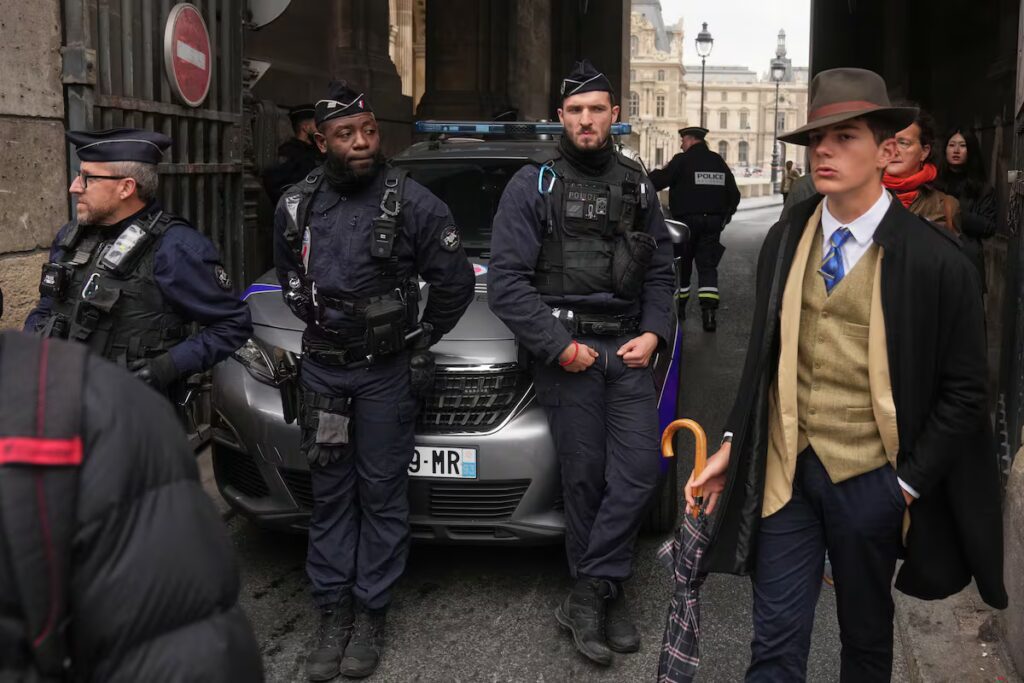On October 19, a dramatic heist unfolded at the Louvre Museum in Paris, reminiscent of a movie plot. Thieves gained access to the renowned Apollo gallery using a movable staircase and an angle grinder, successfully stealing nine jewels from the French crown, though they inadvertently dropped an actual crown during their escape.
Table of Contents
ToggleCinematic Presence at the Scene
An image captured by Thibault Camus of the Associated Press went viral, depicting a mysterious figure next to police officers. Dressed in a trench coat and tilted hat reminiscent of classic film noir characters like Humphrey Bogart, this figure captured the imagination of many, suggesting that France‘s cultural identity would endure despite the theft.
The Mysterious “Fedora Man”
Social media buzzed with speculation about the identity of the so-called “Fedora Man.” Some viewers even wondered if this character, looking more suited to 1920s crime stories than modern Paris, had been created using AI. Camus clarified that he did not know the identity of the man, who piqued his interest because of his distinctive appearance amidst the historical robbery. Was he merely an observer or perhaps even the thief?
A Surprising Revelation
In a twist worthy of the story, the man turned out to be a 15-year-old named Pedro Elías Garzón Delvaux. On the day of the heist, he was visiting the Louvre with his mother and grandfather. Dressed in his signature style, which he adopts daily, Garzón Delvaux didn't simply put on a costume for the museum visit—he naturally dresses this way. With Colombian heritage on his father's side, he expressed a fondness for history and the WWII era, crediting his unique style to an interest that began when he dressed as Jean Moulin, a hero of the French resistance, for a school party.
Family Background and Context
Pedro's mother, Félicité Douce de La Salle, shared insights into his sense of style, attributing it partially to influences from their time living in Seville, Spain. She noted that Pedro Elías dresses elegantly, inspired by the well-dressed culture of the Feria de Sevilla. His distinctive fashion sense has attracted media attention, but she views it positively, preferring it over more common teenage trends.
The Day of the Theft
The family was unaware of the robbery as they enjoyed their visit. As they left the museum, they encountered Thibault Camus, taking the now-famous photograph. It wasn't until later that they learned of the dramatic theft, having been disconnected from their phones during their museum experience.
Fashion and Identity
Garzón Delvaux's impressive mustache contributed to the initial skepticism about his age. His mother confirmed that it is indeed his first mustache, reflecting a youthful interest in appearance. Following the media frenzy, Pedro has experienced a surge of interest from peers and even received proposals to star in projects inspired by his unexpected fame.
Family Support and Cultural Influence
The family's literary background, with Garzón Delvaux's grandfather being writer Bruno de La Salle, has further enriched his narrative. Garzón Delvaux's unique wardrobe pieces, including his grandmother's fedora, have added a sentimental touch, connecting him to his family history. The family is actively managing the attention surrounding him, balancing requests and media engagement.
A Young Influencer's Perspective
Garzón Delvaux expressed delight in the mystery surrounding his image and found the public's theories amusing. His fashion sense, which includes items passed down from family members and thrift finds, reinforces the idea that good taste is timeless. Despite his young age, his music preferences lean toward classic artists, showcasing his eclectic and mature style.











